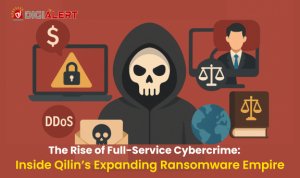Displaying items by tag: DigitalRisk
Qilin Ransomware’s Sinister “Call Your Lawyer” Tactic: A Wake-Up Call for Business Leaders
In a threat landscape where cybercriminals are constantly innovating, ransomware has taken a disturbing psychological turn. The infamous Qilin ransomware group has recently introduced a new tactic—embedding the phrase “Call Your Lawyer” in their ransom notes. This isn’t just a clever line; it’s a deliberate psychological ploy designed to escalate panic, accelerate payment decisions, and deter law enforcement involvement.
Have you ever clicked on a Discord invite that looked completely normal—only to realize something wasn’t right?
In 2024, cybercriminals are increasingly hijacking legitimate-looking Discord invites to spread malware, steal credentials, and compromise entire organizations. What began as a communication tool for gamers has evolved into a platform used by developers, startups, and communities worldwide—and that’s precisely why it’s now under attack.
WordPress Sites Under Attack: How Hackers Are Exploiting Vulnerabilities and What You Can Do
With over 43% of all websites on the internet built using WordPress, it’s no surprise that the platform is a favorite target for cybercriminals. While its flexibility, massive plugin ecosystem, and ease of use make it a go-to CMS for businesses and developers, its popularity also presents an enticing opportunity for hackers.
Former Black Basta Members Now Exploit Routers in New Cyberattacks – Here’s What You Need to Know
Cybercrime doesn’t retire—it reinvents. In the ever-evolving world of cybersecurity, attackers are constantly shifting tactics to find new weak points. Recent threat intelligence reports have revealed that former members of the Black Basta ransomware group—once known for crippling organizations with double-extortion attacks—have pivoted from traditional endpoints and servers to a more insidious target: enterprise routers.
Did you know that 60% of all cyber breaches are linked to unpatched vulnerabilities?
In today’s hyperconnected world, one overlooked update can lead to catastrophic consequences. Adobe’s recent security release, patching 25 critical vulnerabilities, is a loud wake-up call for enterprises, government agencies, and individual users alike.
Why Over 70 Organizations Were Targeted in a Single Cyberattack – And How to Avoid Being Next
Imagine this: You step into the office, open your laptop, and discover your company’s data is encrypted, your systems locked, and a ransom note flashing across your screen.
This nightmare recently became a grim reality for over 70 organizations across industries including finance, healthcare, and technology. A highly coordinated cyberattack, leveraging multiple threat vectors, exposed glaring weaknesses in enterprise defenses and sent shockwaves across the cybersecurity landscape.
Did you know that over 90% of public cloud workloads run on Linux? This widespread adoption underscores Linux’s reputation as the backbone of enterprise computing, powering everything from cloud-native applications and IoT infrastructure to edge devices and high-performance clusters.
Artificial Intelligence (AI) is reshaping the way the world works. Whether it’s automating repetitive tasks, assisting in decision-making, or enhancing productivity, AI-powered tools are now a staple in most organizations. In fact, a staggering 74% of businesses use AI tools daily, according to a recent industry study.
Ransomware has morphed from a fringe cybersecurity nuisance into one of the most disruptive and costly forms of cybercrime facing individuals, businesses, and governments worldwide. In 2024, ransomware payments exceeded $1.1 billion, according to Chainalysis—a chilling all-time high. But that’s just the beginning. These figures do not include the far more substantial costs of downtime, forensic investigations, legal consultations, reputational damage, and regulatory fines, which often outstrip the ransom itself.
In an increasingly digital world where rapid application development is paramount, developers heavily rely on open-source package ecosystems like npm (Node Package Manager) to streamline their workflow. These repositories promise speed, collaboration, and innovation—but they also introduce a critical and often overlooked threat vector: supply chain attacks.
















